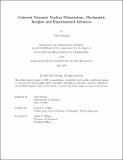Coherent Dynamic Nuclear Polarization: Mechanistic Insights and Experimental Advances
Author(s)
Ouyang, Yifu
DownloadThesis PDF (5.274Mb)
Advisor
Griffin, Robert G.
Terms of use
Metadata
Show full item recordAbstract
Dynamic Nuclear Polarization (DNP) enhances the sensitivity of solid-state Nuclear Magnetic Resonance (NMR) by transferring polarization from electrons to nuclei. While traditional continuous-wave (CW) DNP has advanced through improved radical design, the development of pulsed DNP—employing short, high-power microwave bursts—has shown the advantages of coherent spin control. We present both theoretical and experimental investigations aimed at understanding and optimizing polarization transfer. On the theoretical side, we examined multiple DNP mechanisms, including a re-evaluation of the Overhauser effect in insulating solids and a foundational treatment of the chirped solid effect. We also identified a new transfer channel, termed Resonant Mixing, arising from interference effects under off-resonance driving. Building on these insights, we developed a general framework for analyzing amplitude-, phase-, and frequency-modulated pulses. This approach enables the design of hybrid pulse sequences that combine modulation and chirping to produce efficient, selective spin transfer. These sequences maintain high enhancement even at reduced microwave power, thereby improving scalability to high magnetic fields. To test the practical viability of this approach, we designed and evaluated a prototype 400 MHz/263 GHz probe incorporating new resonator and RF technologies. While the initial performance was limited, the system provided a testbed for future high-field pulsed DNP experiments under realistic conditions. Together, these results establish a theoretical and technical foundation for next-generation pulsed DNP, emphasizing coherent spin manipulation, power-efficient design, and applicability to high-field, static-solid NMR systems.
Date issued
2025-05Department
Massachusetts Institute of Technology. Department of ChemistryPublisher
Massachusetts Institute of Technology